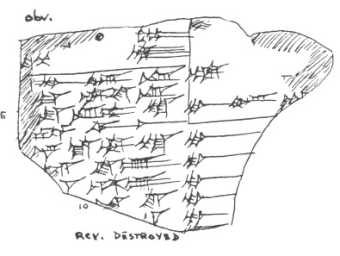The Lexical Texts from Šibaniba (Tell Billa)
| 1. [gud ĝeš tag]-ga | sacrifical oxen |
| 2. [gud ĝeš du₃-a] | breeding bull |
| 3. [gud] šag₄-gu₂ | ? |
| 4. gud šu-gi | old oxen |
| 5. gud šu-gi-na | oxen for the šuginu offering |
| 6. gud mah | full grown oxen |
| 7. gud-a₂-la₂-ba | bison |
| 8. [gud] a₂-la₂ | ? |
| 9. [gud] šag₄-gu₂ | lead oxen |
| 10. g[ud] ti-ti | ? |
| 11. g[ud] niga | masted oxen |
| 12. g[ud niga] sig₅-ga | quality masted oxen |
| 13. g[ud i]b₂-la₂ | long tailed oxen |
| 14. gud an-na | ox of heaven |
| 15. gud zubi? | hairy oxen |
| 16. gud [dumu] dut[u] | Bull man |
| 17. gud saĝ-ki babbar | ox with white forehead |
The two lexical texts from Šibaniba, north of Assur, are of unusual interest, because they connect both to the past and to the future. Šibaniba (Tell Billa) was located in the central Assyrian area. The Middle Assyrian texts from the site date to the reign of Shalmaneser I (13th century) and belonged to the administration of the district governor (hassihlu) who was a mid-level functionary between the crown on the one hand and local dignitaries on the other hand.
The largest of the two tablets is a list of domestic animals in Sumerian only and belongs to the Ura series. The text, UM 33-58-140, originally had three columns on each side. The beginning of the second column is edited in the box to the right.
Remarkably, this is almost word for word identical to the Ugarit version RS 17.40, and corresponds to the little that is left of the Emar version in Msk 7520+. Most remarkable is the spelling gud a₂-la₂-ba for gud alim (bison). Emar, Ugarit, and the area around Assur had all been part of the Mittani empire, and they all shared the Mittanni literate culture including the lexical tradition.

UM 33-58-064. Line drawing by Jacob J. Finkelstein, Journal of Cuneiform Studies 7 (1953) 166 (text 58)
The second Šibaniba text is a little fragment of the acrographic list Izi. This fragment accords with a library copy with colophon from Middle Assyrian Assur (MRAH O.0314). The colophon of that latter text reads:
Tablet 6 of the series Izi = išātu
Finished; collated.
Written by Aššur-šu-[...].
With these two tablets Šibaniba is thus connected on the one hand with the Mitanni tradition, as continued in Emar, Ugarit, and other places, and on the other hand with the traditions that were cultivated in the royal city of Assur. Through the Mitanni tradition the Šibaniba texts are related to the Middle Babylonian and Old Babylonian traditions. The Assur corpus, however, may be regarded as the first outpost of the first millennium. The Šibaniba lexical texts thus present themselves as being situated between the old school traditions of the area and the latest trends in the capital.
27 Dec 2019
Further reading
- Finkelstein, Israel 1953 Cuneiform Texts from Tell Billa. Journal of Cuneiform Studies 7: 111-76.
- Jakob, Stefan 2003 Mittelassyrische Verwaltung und Sozialstruktur. Untersuchungen. Cuneiform Monographs 29. Leiden: Brill-STYX.
Niek Veldhuis
Niek Veldhuis, 'The Lexical Texts from Šibaniba (Tell Billa)', Digital Corpus of Cuneiform Lexical Texts, The DCCLT Project, 2019 [http://oracc.museum.upenn.edu/dcclt/lexicallistsperiods/middlebabylonian/shibaniba/]